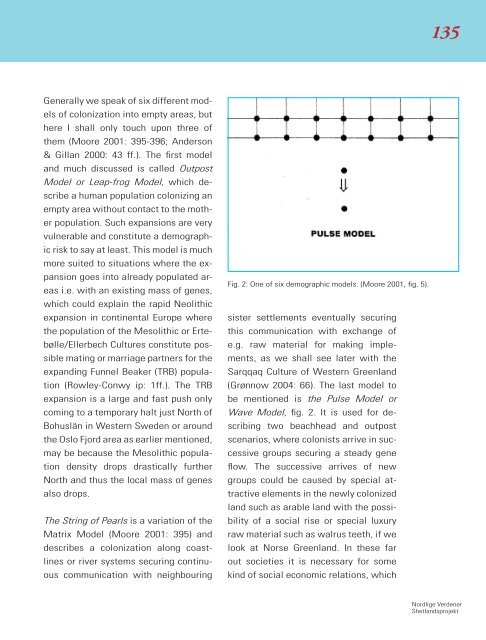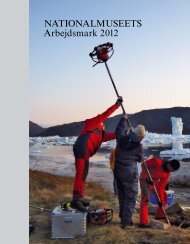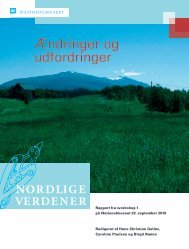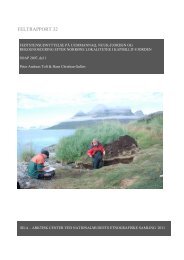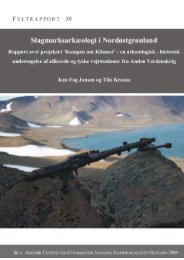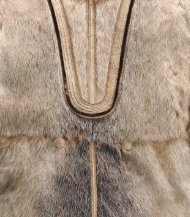The Border of Farming and the Cultural Markers - Nordlige Verdener
The Border of Farming and the Cultural Markers - Nordlige Verdener
The Border of Farming and the Cultural Markers - Nordlige Verdener
You also want an ePaper? Increase the reach of your titles
YUMPU automatically turns print PDFs into web optimized ePapers that Google loves.
135<br />
Generally we speak <strong>of</strong> six different models<br />
<strong>of</strong> colonization into empty areas, but<br />
here I shall only touch upon three <strong>of</strong><br />
<strong>the</strong>m (Moore 2001: 395-396; Anderson<br />
& Gillan 2000: 43 ff.). <strong>The</strong> first model<br />
<strong>and</strong> much discussed is called Outpost<br />
Model or Leap-frog Model, which describe<br />
a human population colonizing an<br />
empty area without contact to <strong>the</strong> mo<strong>the</strong>r<br />
population. Such expansions are very<br />
vulnerable <strong>and</strong> constitute a demographic<br />
risk to say at least. This model is much<br />
more suited to situations where <strong>the</strong> expansion<br />
goes into already populated areas<br />
i.e. with an existing mass <strong>of</strong> genes,<br />
which could explain <strong>the</strong> rapid Neolithic<br />
expansion in continental Europe where<br />
<strong>the</strong> population <strong>of</strong> <strong>the</strong> Mesolithic or Ertebølle/Ellerbech<br />
Cultures constitute possible<br />
mating or marriage partners for <strong>the</strong><br />
exp<strong>and</strong>ing Funnel Beaker (TRB) population<br />
(Rowley-Conwy ip: 1ff.). <strong>The</strong> TRB<br />
expansion is a large <strong>and</strong> fast push only<br />
coming to a temporary halt just North <strong>of</strong><br />
Bohuslän in Western Sweden or around<br />
<strong>the</strong> Oslo Fjord area as earlier mentioned,<br />
may be because <strong>the</strong> Mesolithic population<br />
density drops drastically fur<strong>the</strong>r<br />
North <strong>and</strong> thus <strong>the</strong> local mass <strong>of</strong> genes<br />
also drops.<br />
<strong>The</strong> String <strong>of</strong> Pearls is a variation <strong>of</strong> <strong>the</strong><br />
Matrix Model (Moore 2001: 395) <strong>and</strong><br />
describes a colonization along coastlines<br />
or river systems securing continuous<br />
communication with neighbouring<br />
Fig. 2: One <strong>of</strong> six demographic models. (Moore 2001, fig. 5).<br />
sister settlements eventually securing<br />
this communication with exchange <strong>of</strong><br />
e.g. raw material for making implements,<br />
as we shall see later with <strong>the</strong><br />
Sarqqaq Culture <strong>of</strong> Western Greenl<strong>and</strong><br />
(Grønnow 2004: 66). <strong>The</strong> last model to<br />
be mentioned is <strong>the</strong> Pulse Model or<br />
Wave Model, fig. 2. It is used for describing<br />
two beachhead <strong>and</strong> outpost<br />
scenarios, where colonists arrive in successive<br />
groups securing a steady gene<br />
flow. <strong>The</strong> successive arrives <strong>of</strong> new<br />
groups could be caused by special attractive<br />
elements in <strong>the</strong> newly colonized<br />
l<strong>and</strong> such as arable l<strong>and</strong> with <strong>the</strong> possibility<br />
<strong>of</strong> a social rise or special luxury<br />
raw material such as walrus teeth, if we<br />
look at Norse Greenl<strong>and</strong>. In <strong>the</strong>se far<br />
out societies it is necessary for some<br />
kind <strong>of</strong> social economic relations, which<br />
<strong>Nordlige</strong> <strong>Verdener</strong><br />
Shetl<strong>and</strong>sprojekt


